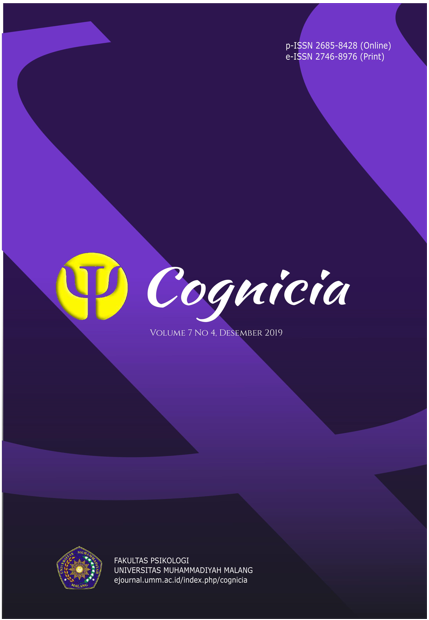Konsep diri, kematangan emosi, dan perilaku bullying pada remaja
DOI:
https://doi.org/10.22219/cognicia.v7i4.9231Keywords:
self concept, emotional maturity, behavior bullying, adolescenceAbstract
Bullying behavior is an act of violence committed to harm other people. Bullying behavior can be reduced or controlled by the existence of positive psychological variables, namely self-concept and emotional maturity. The aim of the study is to know, dig, review and organize theoretical and empirical information about self-concept relationships, emotional maturity with bullying behaviour in adolescents. Self-concept, emotional maturity, and bullying behavior studied in 150 early adolescents with an age range of 12 – 15 years. This research is a quantitative study with a partial correlation design and sampling techniques used is the sampling of quotas. The results showed no relation between self-concept and bullying behavior when the maturity of emotions was controlled (r = -0.040; p = 0.625).Downloads
References
Anderson, C. A., & Bushman, B. J. (2002). Human aggression. Annual Review of Psychology, 27–51.
Astuti, ponny retno. (2008). Meredam bullying. 3 cara efektif mengatasi kekerasan pada anak. Jakarta: Kompas Gramedia.
Berzonsky, M. . (1981). Adolescent development. New York: Macmillan Publishing.
Blakely-McClure, S. J., & Ostrov, J. M. (2016). Relational aggression, victimization and self-concept: testing pathways from middle childhood to adolescence. Journal of Youth and Adolescence, 45(2), 376–390.
Daniel, G. (1999). Kecerdasan emosional untuk mencapai puncak prestasi. Jakarta: PT Gramedia Pustaka Utama.
Dariyo, A. (2007). Psikologi perkembangan anak usia tiga tahun pertama (psikologi atitama). Bandung: Refika Aditama.
Due, P., Holstein, B. E., Lynch, J., Diderichsen, F., Gabhain, S. N., Scheidt, P., & Currie, C. (2005). Bullying and symptoms among school-aged children: International comparative cross sectional study in 28 countries. European Journal of Public Health, 15(2), 128–132.
Education.com. (2012). Bullying at school and online. Education.com. Fanti, K. A., & Henrich, C. C. (2015). Effects of self-esteem and narcissism on bullying and victimization during early adolescence. Journal of Early Adolescence, 35(1), 5–29.
Goodstein, P. K. (2013). How to stop bullying in classrooms and school. New York: Routledge.
Guswani, A., & Kawuryan, F. (2011). Perilaku agresi pada mahasiswa ditinjau dari kematangan emosi. Jurnal Psikologi Pitutur, 1(2), 86–92.
Hurlock, B. (1998). Perkembangan Anak. Jakarta: Erlangga. Jahja, Y. (2011). Psikologi perkembangan. Jakarta: Prenadamedia Group.
Kail, Robert V & Cavanaugh, J. C. (2015). Essentials of human development: a life-span view. Boston: Cengage Learning.
KumparanSTYLE. (2017). Kasus bullying meningkat, pelaku didominasi oleh remaja. Retrieved April 19, 2017, from https://kumparan.com/@kumparanstyle/kasus-bullying-meningkat-pelaku-didominasi-oleh-remaja
Muzdalifah, F., & Afriyanto, H. B. (2014). Pengaruh konsep diri terhadap perilaku bullying pada mahasiswa di universitas X. Jurnal Penelitian dan Pengukuran Psikologi, 3(2), 59–64.
Owuamanam, D. O., & Makinwa, V. I. (2015). Prevalence of bullying among secondary school students in Ondo State, Nigeria. European Scientific Journal, 11(20), 1857–7881.
Paul, L. (2003). Bullying at school - school environment (CA Dept of Education).
Rakhmat, J. (2007). Psikologi komunikasi (Ed. Revisi). Bandung: PT Remaja Rosda Karya.
Rigby, K. (2001). Stop the bullying: A handbook for schools. Australian: National Library of Australia Cataloguing
Saifullah, F. (2010). Hubungan antara konsep diri dengan bullying pada siswa-siswi SMP (SMP Negeri 16 Samarinda). Jurnal Psikologi, 4(2), 200–213.
Santrock, J. . (2007). Life-span development: Perkembangan masa hidup, jilid 1, edisi ketigabelas. Jakarta: Erlangga.
Sari, S. . (2018). Hubungan kematangan emosi dengan kecendrungan perilaku bullying pada remaja akhir di SMA XI Yogyakarta. Skripsi, Universitas Isalam Indonesia, Yogyakarta.
Sejiwa. (2008). Bullying: Mengatasi kekerasan di sekolah dan lingkungan sekitar anak. Jakarta: Grasindo.
Singh, M. (2016). A study of aggression among adolescents in relation to their emotional maturity. Scholarly Research Journal for Interdisciplinary Studies (4), 3091–309727.
Sugiyono. (2016). Metode penelitian kuantitatif, kualitatif, dan R&D. Bandung: Alfabeta.
Telussa, A. D. E. M., Persulessy, E. R., & Leleury, Z. A. (2013). Penerapan analisis korelasi parsial untuk menentukan hubungan pelaksanaan fungsi manajemen kepegawaian dengan efektivitas kerja pegawai ( Studi Kasus pada Badan Pendapatan , Pengelolaan Keuangan dan Aset Daerah Provinsi Maluku ). Jurnal Barekeng, 7(1), 15–18.
Walgito, B. (2002). Pengantar psikologi umum. Yogyakarta: Andi Offeset.
Downloads
Published
How to Cite
Issue
Section
License
Copyright (c) 2019 Nurul Aulina

This work is licensed under a Creative Commons Attribution-ShareAlike 4.0 International License.
Authors who publish with Jurnal Cognicia agree to the following terms:
- For all articles published in Jurnal Cognicia, copyright is retained by the authors. Authors give permission to the publisher to announce the work with conditions. When the manuscript is accepted for publication, the authors agree to automatic transfer of the publishing right to the publisher.
- Authors retain copyright and grant the journal right of first publication with the work simultaneously licensed under a Creative Commons Attribution-ShareAlike 4.0 International License that allows others to share the work with an acknowledgment of the work's authorship and initial publication in this journal.
- Authors are able to enter into separate, additional contractual arrangements for the non-exclusive distribution of the journal's published version of the work (e.g., post it to an institutional repository or publish it in a book), with an acknowledgment of its initial publication in this journal.
- Authors are permitted and encouraged to post their work online (e.g., in institutional repositories or on their website) prior to and during the submission process, as it can lead to productive exchanges, as well as earlier and greater citation of published wor (See The Effect of Open Access).

This work is licensed under a Creative Commons Attribution-ShareAlike 4.0 International License







